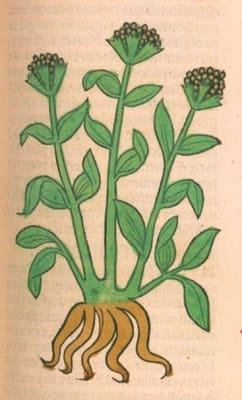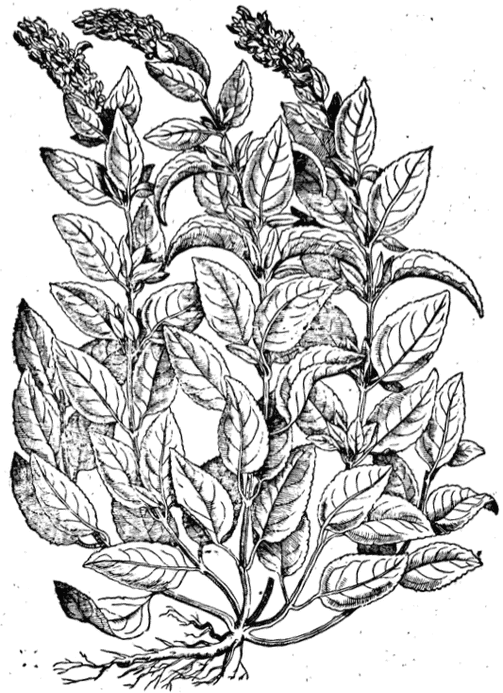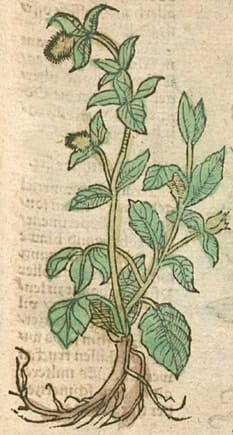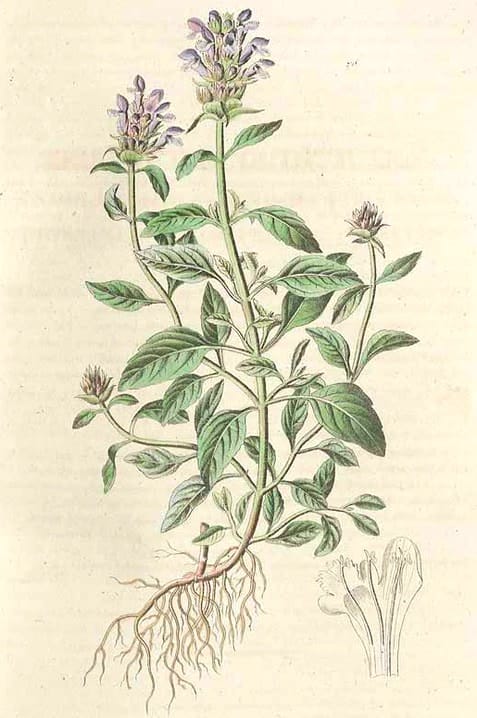Prunella, Self-heal, Xia Ku Cao 夏枯草Also called Consolida minorXia Ku Cao (TCM) |

|
 Ortus Sanitatis, Meydenbach, 1491
Ortus Sanitatis, Meydenbach, 1491

|

|
|
New Kreuterbuch, Matthiolus, 1563 |
Kurtzes Handtbuchlein, Ryff, 1599 |
 Dietrich, Flora regni borussici, 1834
Dietrich, Flora regni borussici, 1834Botanical name:
Prunella vulgaris
Prunella hispida is also used in parts of China.
Parts used:
Flowering tops; Herb
Temperature & Taste:
Cool, dry. (Warm in the West). Slightly Sweet, Bitter, Pungent
Bitter, Cleansing, Binding
Classifications:
2D ATTENUATERS OF CONGEALED BLOOD
2T. GLUTINATE
TCM:
B. Clear Strong Heat or Fire
Uses:
1. Clears Liver Heat (TCM, West):
-red, swollen, painful eyes
-Headache, Dizziness, Convulsions, Vertigo, Epilepsy
-Hepatitis
-Hypertension; it has also been regarded as effective for Hypotension
-Hyperthyroidism
2. Clears Heat and Poison:
-Toxic Sores, Abscesses, Carbuncles
–‘the bites of Mad Dogs and Venomous beasts’ (Culpeper)
-also taken to prevent Infection during epidemics including Measles
–‘Quinsey [Tonsillitis], sores and ulcers of the mouth and jaws’. (Salmon)
-Dysentery (TCM)
-Viral infections including Herpes, Glandular Fever, Mumps, HIV etc.
3. Clears Heat and Poison, Resolves Masses:
-phlegm and heat-type Scrofula, Goiter, Lymphadenitis, Swollen Glands in the neck, and various other nodes and swellings
-used as a stand-alone herb for Scrofula, including those that have ruptured or ulcerated
-special for Mastitis, Abscesses, Tumors and Cancer of the Breast
-other Tumors and Cancers including Lymphoma
4. Clears Heat, Clears Stasis, Promotes Healing:
-A valuable Vulnerary (Wound herb); long used internally or externally for all sorts of Wounds, Bruises, internal Bleeding
-internal or external Ulcers, including Ulcers of the mouth, anus, vagina, and Lungs.
-Fractures and Dislocations (int. & ext.)
-‘used chiefly in Wounds of the Lungs’. (Schroder)
–‘the Essence hereof taken inwardly causes all wounds inward and outwardly to heal’. (Salmon)
5. Moves the Blood, Clears Blood Stasis:
-Amenorrhea, sluggish Menstruation
-Postpartum Hemorrhage
-‘Expels a dead child’ (Culpeper)
–‘Dissolves congealed blood’. (Salmon)
6. Clears Heat and Damp, Promotes Urine:
-Difficult Urination and Edema.
-‘helps all joint aches’ and ‘is excellent for all griefs of the Sinews’ (Culpeper); Gout and Arthritis (TCM, West).
-In Europe it has also been used for Jaundice, Gravel and Stones.
7. Clears Heat, Stops Cough:
-‘A Great Pectoral’ (Salmon)
-heat-type Cough and Lung disease
8. Kills Worms.
9. Externally:
-topically for all inflammations (plaster)
-topically to minor skin Sores, Infections and Rashes
-used for various Wounds and Ulcers (plaster, or fresh herbs beaten and applied)
-topically applied to the bites of Rabid Dogs and other venomous Bites. (plaster, or fresh herb beaten and applied)
-applied to Cramps, Pain and Spasms of the Sinews and Tendons. (the ointment or plaster is applied topically)
-as a mouth wash or gargle for all sores and inflammations of the Mouth, Gums and Throat.
Comment:
Prunella is a valuable medicine, used in East and West, with several important spheres of activity:
1. Liver Heat
2. Hyperthyroidism; Scrofula and nodules of the neck; Cancer
3. Wounds; congealed Blood
4. Various Viral diseases
Despite the fact that it is viewed as Cold in TCM, Prunella is drunk as a health beverage in parts of China.
Dose:
It is drank as tea during the summer to clear heat.
DECOCTION or LONG INFUSION: 6–15 grams, up to 30 grams in severe cases (20–60 grams fresh). Around 45 grams is the normal maximum daily dose of the dried herb, which is built up to and used only if needed;
POWDER: 1–4 grams
TINCTURE (1:5): 2–5 mls;
FRESH JUICE: 5 drops up to 10 mls. are added to a glass of warm water, and this is taken as a dose.
SYRUP of the FRESH JUICE made with HONEY: taken in teaspoonful doses
Substitute:
1. Bugle
2. Prunella is a substitute for Stoechas in Unani medicine.
Main Combinations:
1. Liver Heat:
i. Self Heal with Dandelion, Peppermint
ii. Self Heal with Gentian, Scutellaria Huang Qin (TCM)
iii. Self Heal with headache, dizziness, red and sore eyes, with Cyperus rotundus and Licorice (Xia Ku Cao San from the Zhang Shi Yi Tong [Comprehensive Medicine according to Master Zhang]).
2. Hyperthyroidism, Liver Heat:
i. Self Heal with Balm
ii. from excess Liver heat, Self Heal with Scutellaria Huang Qin, Gardenia Zhi Zi, Gentiana Long Dan Cao
3. Scrofula, Lymphatic swelling:
i. Self Heal with Figwort
ii. Self Heal with Kelp, Licorice (as in Decoction of Self Heal and Kelp)
iii. Self Heal with Hyssop and Peppermint (as in Decoction of Self Heal)
iv. Self Heal with Balm, Walnut leaf, St. John’s wort, Calendula
v. Self Heal with Kelp and Figwort (Xuan Shen) (TCM)
vi. Self Heal with Fritillaria Bei Mu, Cyperus rotundus (Xiang Fu) for Phlegm-heat with Liver Qi stagnation (Xia Ku Cao Tang from Wai Ke Zheng Zong [True Lineage of External Medicine]).
4. Goiter, Self Heal, Oyster shell (Mu Li), Fritillaria Bei Mu
5. Hypertension:
i. Self Heal with Mistletoe, Peony
ii. Self Heal with Hawthorn, Balm
6. Sore, red eyes:
i. Self Heal with Eyebright
ii. Self Heal with Goji berries and Chrysanthemum (Ju Hua)
iii. Self Heal with Chrysanthemum (Ju Hua) and Cassia seed Jue Ming Zi
iv. Redness, tearing, pain of the eyeballs, photophobia, Self Heal with Cyperus rotundus (Bu Gan San from Jian Yao Ji Zhong Fang [Brief Prescriptions that Aid All People])
v. Liver deficient Eye pain, Self Heal, Cyperus rotundus
7. Deviation of the Eyes and Mouth (ie. Post Stroke), Self Heal, Saposhnikovia Fang Feng, Arisaema prepared with Bile (Dan Nan Xing) (from Southern Yunnan Materia Medica)
8. Sore and Swollen Throat, Tonsilitis:
i. decoct 60–90 grams of fresh Self Heal, decoct and drink over the day. (Compilation of Simple Prescriptions of Herbal Medicine and Herbal Medicine)
ii. Self Heal with Sage, Tormentil, Marshmallow, Elder flower, Licorice (Gazophylacium Medico-Physicum, Woyts, 1746)
9. Mastitis, Breast Lumps:
i. Self Heal, Dandelion (Pu Gong Ying) (equal parts). decocted in wine or made into pills
ii. Self Heal, Bupleurum Chai Hu, Fritillaria Bei Mu, Paeonia rubra Chi Shao Yao
10. Bleeding, take 1 teaspoonful of Self Heal powder with rice soup.
11. Leukorrhea with Blood, take 6 grams of the powder of Self Heal
12. Wound including Knife wounds, chew fresh Self Heal and apply
13. Non-healing Wounds, Self Heal, Lady’s Mantle, Sanicle, Tormentil (Herbarium Horstianum, 1630)
14. Wash for Sores and skin inflammations, Self Heal with Honeysuckle flower (Jin Yin Hua) or Camomile
15. A wash for Wounds and Ulcers, Self Heal with Bugle and Sanicle (Culpeper)
16. Fractures, combine Self Heal with Comfrey, both internally and topically
17. Plaster for Dislocations and Trauma of the Joints, Self Heal with Hollyhock root, Frankincense, Myrrh, Shilajit and Turpentine, made into a plaster with Suet and Oil (The Compleat Bone-setter, Turner, 1656)
18. Headache from Heat and inflammation, Self Heal juice with Vinegar of Roses, applied topically. (Herbarium Horstianum, 1630)
Major Formulas:
Decoction of Self Heal
Decoction of Self Heal and Kelp
Decoction of Timaei (modified)
Powder for Cancerous Ulcers (Gabelhover)
Plaster for Dislocations
Cautions:
Generally Safe.
1. In TCM it is not used for marked weakness (Qi deficiency).
2. It may lower Thyroid function and aggravate Hypothyroid conditions.
Main Preparations used:
Distilled Water of the Herb, Juice, Conserve of the Flowers
1. Conserve of the Flowers:
i. fresh Flower (1 part), Sugar (2 parts). Beat.
2. Juice of Self Heal:
i. Fresh Self Heal; bruise in a stone mortar, sprinkling with a little water; express strongly. Set aside the juice, then decant the clear liquid, preserving in bottles, adding to every pound, 1 dram of alcohol. (Pharmacopoeia Herbipolitania, 1796)
3. Syrup of Self Heal:
i. Juice of Self Heal depurated and reduced to half by slow evaporation (9 oz.), White Sugar (16 oz.). Dissolve. (Pharmacopoeia Wirtembergica, 1798)
-
Extra Info
- Research
